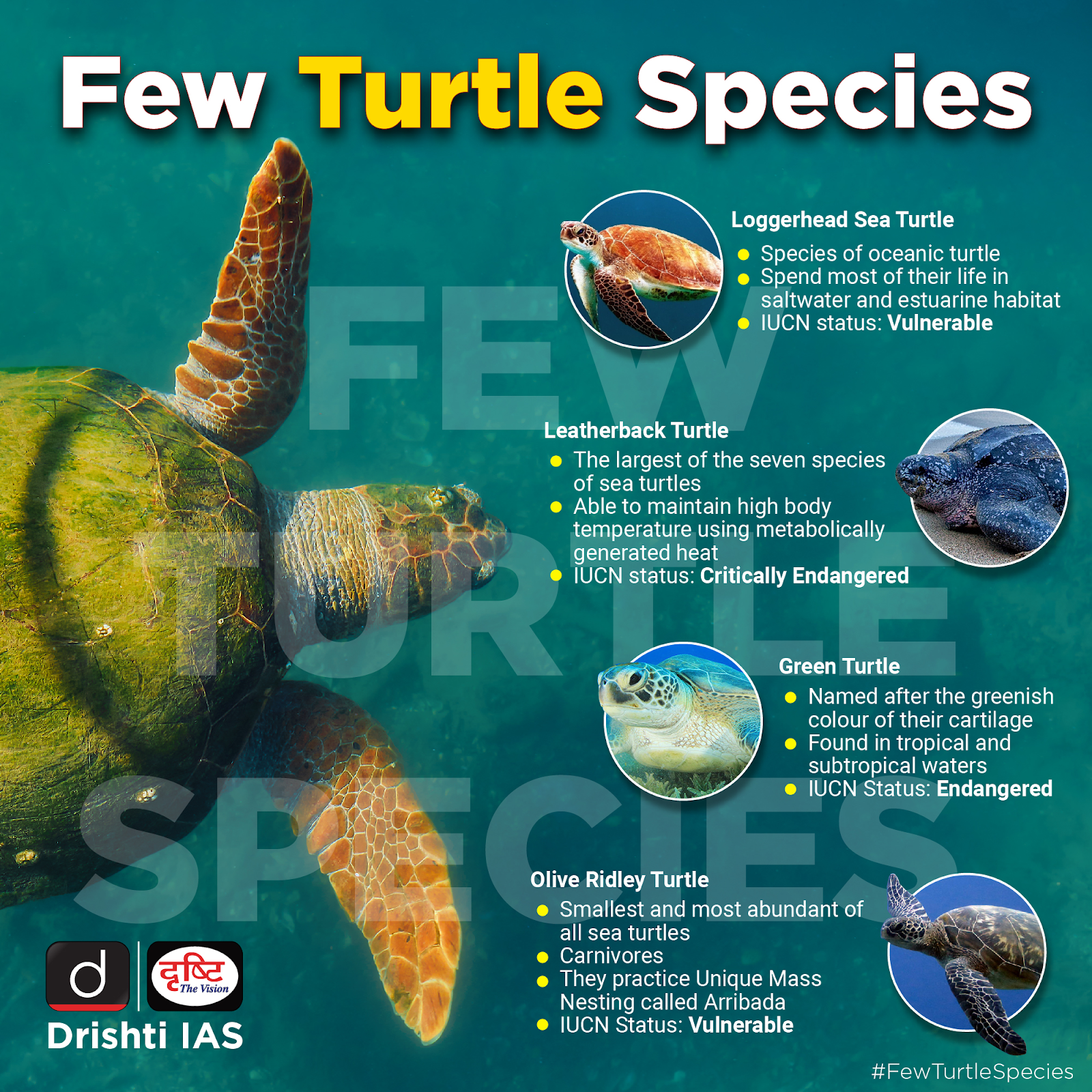Important Facts For Prelims
World Turtle Day 2025
- 24 May 2025
- 5 min read
World Turtle Day is observed annually on 23rd May to highlight the importance of conserving turtles and tortoises.
- The day was established in 2000 to raise awareness and promote conservation of turtles and tortoises globally.
What are the Key Facts Related to Turtles?
- About: Turtles (Order Testudines) are reptiles distinguished by a cartilaginous shell developed from their ribs, forming a protective shield.
- Unlike other animals with shells, turtles cannot shed or exit their shell, as it is an integral part of their skeleton.
- Habitat: Turtles can live in both freshwater and marine (sea) environments.
- Different From Tortoise: Tortoises differ from other turtles primarily by being strictly terrestrial, while many turtle species are partially aquatic.
- Although all tortoises are turtles, not all turtles are tortoises.
- Both are generally shy, solitary animals that lay eggs on land by burying them in nests.
- Key Features: Turtles are cold-blooded (ectothermic) species, i.e they can regulate their body temperature by moving between warmer and cooler environments.
- Like other ectotherms such as insects, fish, and amphibians, they exhibit slow metabolism and can survive extended periods without food or water.
- Key Species:
- Sea Turtles: Loggerhead Turtle, Green Turtle, Hawksbill Turtle, Leatherback Turtle, Olive Ridley Turtle, and Flatback Turtle.
- Freshwater Turtles: Snapping Turtle, Painted Turtle, Red-eared sliderTurtle, Spiny Softshell Turtle and Musk Turtle etc.
What is the State of Turtle Species in India?
- Species in India: India is home to 30 species of freshwater turtles, 26 of which are listed under Schedule I of the Wildlife Protection Act, 1972.
- Assam, West Bengal & Uttar Pradesh have high turtle diversity.
- India also hosts 5 sea turtle species: Olive Ridley, Green, Loggerhead, Hawksbill, and Leatherback. All of which are protected under Schedule I of the Wildlife Protection Act, 1972.
- Protection Status (as per the IUCN Red List):
- Olive Ridley, Loggerhead, and Leatherback: Vulnerable
- Green Turtle: Endangered
- Hawksbill Turtle: Critically Endangered
- Threats: Turtles face severe threats from habitat destruction, climate change, plastic pollution, and illegal wildlife trade for meat, pets, and traditional medicine, with Uttar Pradesh and West Bengal being major trafficking hotspots.
- Conservation Efforts: UP leads in conserving turtles by establishing turtle conservation centres in Kukrail (Lucknow), Sarnath (Varanasi), Chambal (Etawah), and a 30 km Turtle Sanctuary in Prayagraj.
- The Forest Department actively curbs illegal trade, especially in Pilibhit, a major trafficking hotspot identified in WCCB’s Operation Kurma.
- To enhance efforts, a Turtle Conservation and Research Centre is being set up in Pilibhit Tiger Reserve along River Mala, funded by CAMPA.
| Read More: Olive Ridley Turtles in India, Illicit Trade of Tortoises and Hard-Shell Turtles |
UPSC Civil Services Examination, Previous Year Questions (PYQs)
Prelims
Q. Which one of the following is the national aquatic animal of India? (2015)
(a) Saltwater crocodile
(b) Olive ridley turtle
(c) Gangetic dolphin
(d) Gharial
Ans: C
Q. Consider the following statements: (2019)
- Some species of turtles are herbivores.
- Some species of fish are herbivores.
- Some species of marine mammals are herbivores.
- Some species of snakes are viviparous.
Which of the statements given above are correct?
(a) 1 and 3 only
(b) 2, 3 and 4 only
(c) 2 and 4 only
(d) 1, 2, 3 and 4
Ans: (d)








